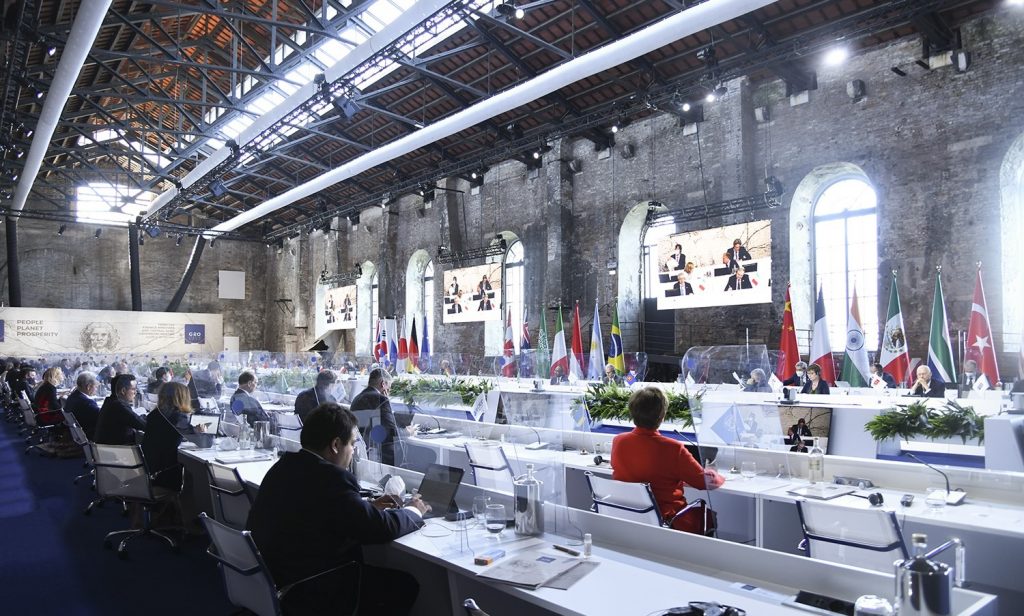 Seema Javed
Seema Javed
In 2021, the international community will need to show courage and ambition in order to overcome the great challenges of today: from recovering from the pandemic to addressing climate change, from supporting innovation to overcoming poverty and inequality.
On July 9 and 10 Third G20 Finance Ministers and Central Bank Governors held a meeting under the Italian Presidency.
Since December 2020 Italy holds the presidency of G20 nations. G20 nations cause 76% of global greenhouse gas emissions. Only half those emissions are covered by ambitious pledges to cut them, under the Paris Agreement.
G20 leaders could get the world on track for COP26 to deliver on the Paris Agreement commitment and keep 1.5° alive.
The G20 Finance Ministers could work to ensure delivery of wealthy nations’ promise of $100bn a year to support climate action and adaptation, to minimize the risk of undermining trust ahead of COP26.
G20 nations with weak targets, like Australia, will be expected to commit to net zero and end reliance on, and export, of fossil fuels. China, the world’s biggest emitter, can lead the way with an ambitious new emissions pledge well ahead of COP26.
Why do G20 nations matter to keep 1.5°C alive at COP26? As the world faces unprecedented and extreme temperatures, driven by climate change, COP26 has a huge job to keep the ambition of the Paris Agreement within reach – to keep 1.5°C alive.
The searing heat that scorched western Canada and the US at the end of June was “virtually impossible” without climate change, say scientists.
In their study, the team of researchers says that the deadly heat wave was a one-in-a-1,000-year event. But we can expect extreme events such as this to become more common as the world heats up due to climate change.
Most countries have yet to up the ambition of their climate action plans before they meet in Glasgow. Delivering that ambition means committing to several areas.
Real plans for fast, deep cuts in emissions, in line with the science, to get to net zero by the middle of this century; Nationally determined contributions (NDCs) are at the heart of the Paris Agreement and the achievement of these long-term goals.
NDCs embody efforts by each country to reduce national emissions and adapt to the impacts of climate change. The Paris Agreement requires each Party to prepare, communicate and maintain successive nationally determined contributions (NDCs) that it intends to achieve.
Parties shall pursue domestic mitigation measures, with the aim of achieving the objectives of such contributions.
Real money to help poorer nations adapt to & pay for loss and damage from climate impacts; The contribution of countries to climate change, and their capacity to prevent and cope with its consequences, varies enormously.
The Convention and the Protocol therefore foresee financial assistance from Parties with more resources to those less endowed and more vulnerable. Developed country Parties (Annex II Parties) shall provide financial resources to assist developing country Parties in implementing the Convention.
To facilitate this, the Convention established a Financial Mechanism to provide funds to developing country Parties.
Real action to end fossil fuel use, deforestation & the most dangerous greenhouse gases.Countries are being asked to come forward with ambitious 2030 emissions reductions targets that align with reaching net zero by the middle of the century.
To deliver on these stretching targets, countries will need to accelerate the phase-out of coal, curtail deforestation, speed up the switch to electric vehicles, encourage investment in renewables.

There are developing nations in the G20 who have yet to enhance their targets, or to enhance them by enough. But they, and many poorer nations, have made the point that they need financial assistance from wealthier countries, not just for climate action, but also to adapt to climate impacts.
Wealthy nations are therefore expected to step up and deliver on their overdue promise of $100bn a year by 2020; failure to so not only limits what developing nations can afford to do, but also risks undermining trust, which would make the job to be done at COP26 in Glasgow much, much harder.
Rich countries have failed to provide the financial assistance needed for the developing world to cut greenhouse gas emissions and cope with the impacts of climate breakdown, poorer nations have warned, after a US summit of world leaders ended with few new funding promises.
The failure leaves billions of people at risk from the worsening ravages of extreme weather, as poor countries struggle with the Covid-19 crisis and rapidly mounting debt.
Our starting point is the COP16 Accord, which states that: “developed country Parties commit, in the context of meaningful mitigation actions and transparency on implementation, to a goal of mobilizing jointly USD 100 billion per year by 2020 to address the needs of developing countries”.
This commitment has been central to the climate accords since 2009 and is an important symbol of trust. Developing countries rightly consider it essential for securing progress and meeting the goals of the Paris Agreement.
It is the bedrock of international climate finance, underpinning international agreement and co-operation on climate action. In highlighting the deepening climate emergency at the UN Climate Action Summit in September 2019, the UN Secretary General underscored the pivotal importance of scaling up and accelerating the delivery of international public finance.
The COVID-19 pandemic has drastically altered the context for international climate finance. It has resulted in the most damaging humanitarian and economic crisis since the Second World War and its impacts have been particularly severe on emerging markets and developing economies (EMDEs).
They have suffered large losses of revenue with knock-on effects on their fiscal and debt positions. 54% of low-income countries are deemed to be in debt distress or at high risk of debt distress as of September 2020, a trend likely to continue into 2021.
The pandemic has also exacerbated the debt pressures on many climate-vulnerable middle-income countries. The world needs to simultaneously tackle the COVID-19 and climate crises. The pandemic has highlighted that the old normal was deeply fragile and dangerous.
Should the world fail to act now, the harm caused by climate change and biodiversity loss will be much greater and longer-lasting than the damage inflicted by COVID-19. The immediate imperative in recovery is to “build back better”, placing the world on a path of sustainable, inclusive, and resilient growth And of course, there are the biggest emitters.
China accounts for upwards of a quarter of global emissions. They have committed to get to net zero by 2060, to peak emissions by 2030, and to start to reduce use of coal after 2025.
But they continue to invest in coal, and their emissions still grow sharply. A strong emissions pledge from China, well before COP26, would be a significant act of leadership from the world’s biggest emitter to bring others along too.
Asia is by far the largest emitter, accounting for 53% of global emissions. As it is home to 60% of the world’s population this means that per capita emissions in Asia are slightly lower than the world average, however.
China is, by a significant margin, Asia’s and the world’s largest emitter: it emits nearly 10 billion tonnes each year, more than one-quarter of global emissions.
North America – dominated by the USA – is the second largest regional emitter at 18% of global emissions. It’s followed closely by Europe with 17%. Here we have grouped the 28 countries of the European Union together, since they typically negotiate and set targets as a collective body.
 Jubilee Post News & Views
Jubilee Post News & Views




